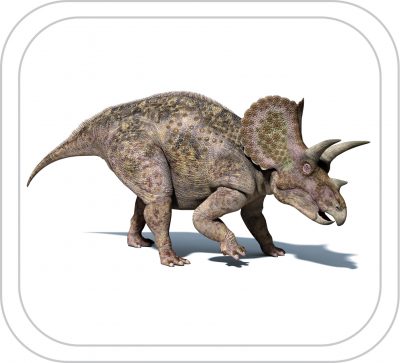Triceratops
Name: Triceratops
Pronounced: tri-SERRA-tops
Meaning: ‘Three-horned face’ from the Greek language, with ‘tri’ meaning three and ‘ceratops’ meaning horned face.
Period: Late Cretaceous (67 – 65 million years ago)
Group: Ceratopsians (horn faces)
Size: It was 9m long and 3m tall. It weighed 5500kg.
Diet: Herbivore
Characteristics: The Triceratops walked on four legs and had three horns, a parrot-like beak and a large frill of about 1m radius. It is believed the horns could have been used to fend off attacks from Tyrannosaurus because in 1997 a partial Triceratops fossil was found, which had a horn that was bitten off, with bite marks that match the Tyrannosaurus. The fossil shows the horn healed after being bitten indicating the Triceratops survived the encounter. Puncture marks on fossil frills show that male Triceratops also used their horns to fight each other, probably to impress females. Triceratops remains are usually found individually, suggesting they may have spent most of their lives alone.
Named by: Othniel Charles Marsh in 1889
Discovery:
Even though the triceratops is one of the most recognisable dinosaurs today, when it was first discovered it was believed to be a type of bison. The first fossils now attributed to Triceratops was a pair of brow horns attached to a skull roof, found near Denver, Colorado in the spring of 1887. Another specimen, collected in 1888 by John Bell Hatcher from the Lance Formation of Wyoming, was at first simply described as another species of Ceratops. It took another year before the dinosaur was actually named.

